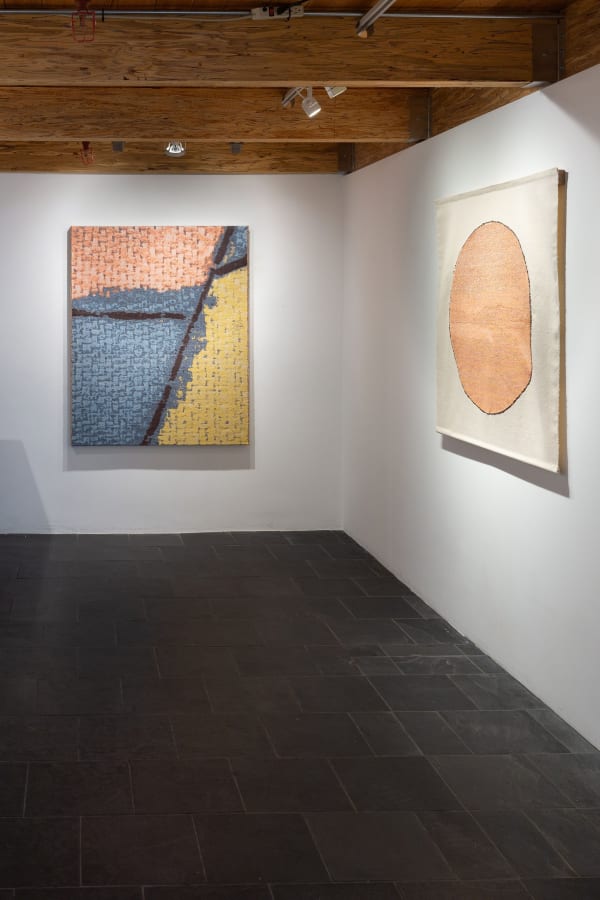Meghan Price: Through Line
Meghan Price rushes to be slow. Her process is a flurry of actions, research, and experimentation, which manifests in the slow meditation of a weaving, her hands and digital jacquard loom working thread by thread to arrive at a new understanding.
Meghan Price’s preceding series highlighted geological forms and materially illustrated how time, pressure, and environment build our world gradually. Throughout her oeuvre, Price has posed questions about our human relationship with the earth, disrupting our material assumptions to their core. A boulder is not a given, not a static thing, it is the outcome of millions of small events over millions of moments. It is each grain of sand. It is every minute. By exposing the underpinnings of our natural world, Price makes us stop and consider our place in these cycles. We are each a single thread in the tapestry of time.
At the height of the pandemic when searching for connections to the outside world, Meghan happened upon the work of Orra White Hitchcock, a 19th century scientific illustrator. White Hitchcock was the wife of scientist and professor Edward Hitchcock and for over four decades acted as his silent collaborator, illustrating his research in geology, botany, zoology and anatomy, regularly joining him in the field. As is often the story of pioneering women, Orra’s autonomy as an artist and scientist was restricted by domestic obligations. She had eight children, tended the home, and cared for Edward through health struggles, all while acting as his scientific confidant and bringing life to his research through vivid paintings.
As a means of paying homage to her artistic forebear, Price has undertaken a new project titled Through Line, directly inspired by the works of Orra White Hitchcock. Working with the archives at Amherst College, Price took macro photographs of White Hitchcock’s geological charts rendered in ink and watercolour on fabric. Rather than looking at the compositions as a whole, Price focused her lens on moments of material articulation where pigment would bleed into fabrics, transgressing the boundaries of the renderings. It is through these small transgressions that Orra’s hand could be most keenly felt. Back in the studio, Price translated these images into trompe l'oeil tapestries. Here, a brush stroke is no longer a momentary action, but is meticulously reconstructed through the accumulation of thousands of intersecting threads. By depicting the fluid qualities of watercolour through the laborious process of weaving, Price creates a liminal space where the action of the gesture is extended indefinitely. — Text by Stanzie Tooth
READ EXHIBITION ESSAY BY STANZIE TOOTH
With thanks to the support of the Superframe Framing Fund.
-
 Vallies Bleed (diptych), 202432.5 x 20.5 in, (x 2 )
Vallies Bleed (diptych), 202432.5 x 20.5 in, (x 2 )
Meghan PriceHandwoven cotton, stitched to canvas, framedSold -
 Strata 1, 202451.5 x 47 in.Meghan PriceHandwoven cotton stitched to stretched canvasCAD 8,400.00
Strata 1, 202451.5 x 47 in.Meghan PriceHandwoven cotton stitched to stretched canvasCAD 8,400.00 -
 Strata 2, 202451.5 x 47 in.Meghan PriceHandwoven cotton stitched to stretched canvasSold
Strata 2, 202451.5 x 47 in.Meghan PriceHandwoven cotton stitched to stretched canvasSold -
 The Movement of Water (diptych), 202452.5 x 40.5 in. (x2)Meghan PriceHandwoven cotton stitched to stretched canvasSold
The Movement of Water (diptych), 202452.5 x 40.5 in. (x2)Meghan PriceHandwoven cotton stitched to stretched canvasSold -
 Crust of the Earth After Orra White Hitchcock, 202440.5 x 40.25 in.Meghan PriceHandwoven cotton, audio tapeSold
Crust of the Earth After Orra White Hitchcock, 202440.5 x 40.25 in.Meghan PriceHandwoven cotton, audio tapeSold -
 Ravine, 202451.5 x 41 in.
Ravine, 202451.5 x 41 in.
Meghan PriceHandwoven cotton, stitched to canvas, framedSold -
 Elevation 1, 202423 x 20.5 in.Meghan PriceHandwoven cotton, stitched to canvasCAD 3,200.00
Elevation 1, 202423 x 20.5 in.Meghan PriceHandwoven cotton, stitched to canvasCAD 3,200.00 -
 Elevation 2, 202423 x 20.5 in.Meghan PriceHandwoven cotton, stitched to canvasSold
Elevation 2, 202423 x 20.5 in.Meghan PriceHandwoven cotton, stitched to canvasSold -
 Convergence (diptych), 202438.5 x 20 in. (x2)Meghan PriceHandwoven cotton stitched to stretched canvasCAD 7,800.00
Convergence (diptych), 202438.5 x 20 in. (x2)Meghan PriceHandwoven cotton stitched to stretched canvasCAD 7,800.00 -
 From the Archive, 202420 x 35 in.
From the Archive, 202420 x 35 in.
Edition of 3Meghan PricePigment print on photo paper mounted on aluminum composite panelCAD 1,400.00


















